| Vintage Pulp | Jan 7 2021 |

Pawn to king's palace—pawn takes queen.
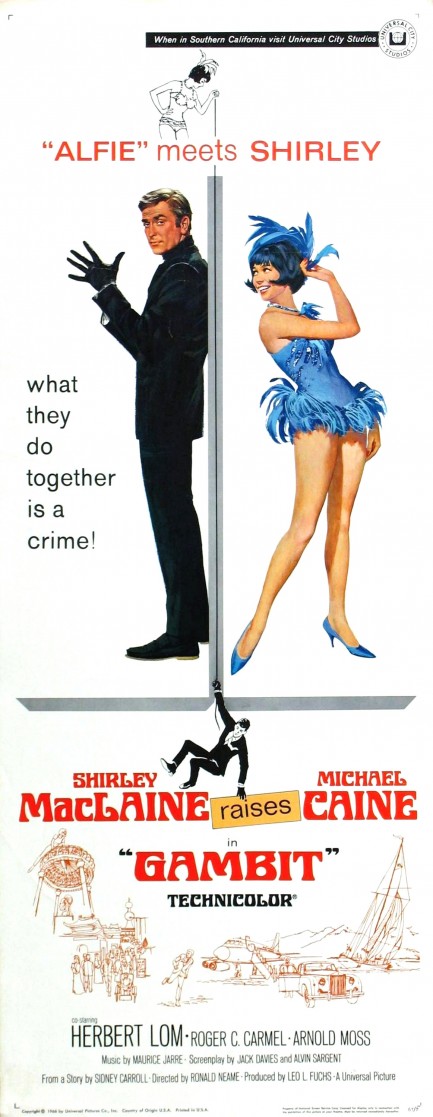
They really don't make many like this anymore. We're talking about high budget adventures in an international setting, combined with romance and a few laughs. Hollywood used to specialize in international glamour, but nowadays in big budget movies Americans go abroad mainly to slaughter or be slaughtered. Gambit, which starred Shirley MacLaine and Michael Caine, and opened nationwide in the U.S. today in 1966, falls into the same category as Charade, To Catch a Thief, The Thomas Crown Affair, How To Steal a Million, Bedtime Story, and numerous other immensely pleasing cinematic excursions. Too bad those are far better films.
Michael Caine plays a con man who has found in Shirley MacLaine the physical double of the dead wife of Ahmad Shahbandar, the richest man in the world. Shahbandar's wife was in turn the virtual double of the ancient Burmese queen Li Szu. Shahbandar has an immensely valuable carved bust of this queen, which he bought for its resemblance to his wife. Caine hopes that once Shahbandar gets a look at MacLaine, he'll let his guard down and invite them into his inner circle, setting himself up for a theft of the bust. If this plot premise seems a bit cluttered to you, we thought the same.
But it doesn't matter because it's not really the main gimmick in the flick. That would be Caine's fantasy of his perfect crime, versus its reality. In his imagining, which makes up the first thirty minutes of the film, MacLaine goes through the motions of the heist like a mute automaton. Then the film restarts with the real MacLaine, and this one talks. Worse for Caine, she has questions, doubts, and, most upsetting of all, opinions. If half an hour of Caine imagining the perfect crime—especially when as a viewer you have no idea it's a fantasy—seems overly long, we thought the same. Again. But we mention it specifically to keep you from turning the film off, which is definitely a possibility for any MacLaine fans dismayed that she's trancewalking through her role. Stick with it and you'll get the same lively star from The Apartment, Irma la Douce, and other hits.
Obviously, we wouldn't have placed this movie in the same category as Charade et al unless there's romance, and MacLaine and Caine—whose names, by the way, sound like a country band or a Vegas magic duo—duly fall in love. But you won't buy it. The script says they fall in love, so okay, by the three-quarters mark they adore each other, but the love spark is never there. Luckily there's also a heist, some comedy, and all the other trimmings of the adventure/romance genre, so despite the film's shortcomings you may find it enjoyable. Then after you finish you can watch any of the movies we mentioned at top and note the difference when this formula is well executed.
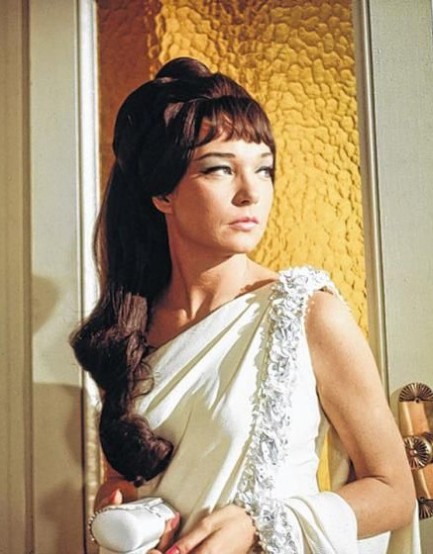 Hi, I'm not Chinese but I get to pretend I am in this movie.
Hi, I'm not Chinese but I get to pretend I am in this movie.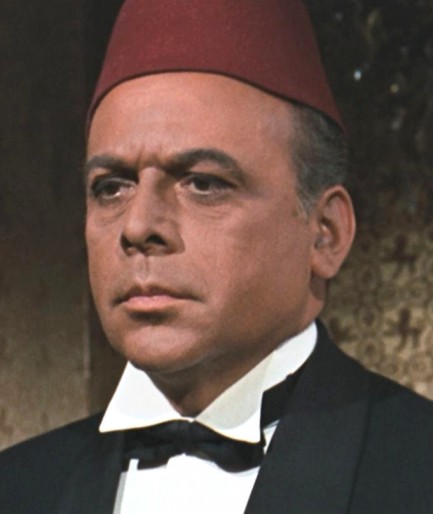 What a coincidence. I get to pretend I'm Arab.
What a coincidence. I get to pretend I'm Arab.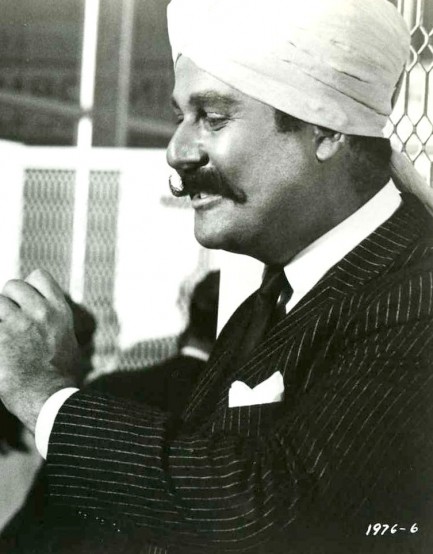 Hi, guess what? I'm white too, but Sikh and you shall find!
Hi, guess what? I'm white too, but Sikh and you shall find!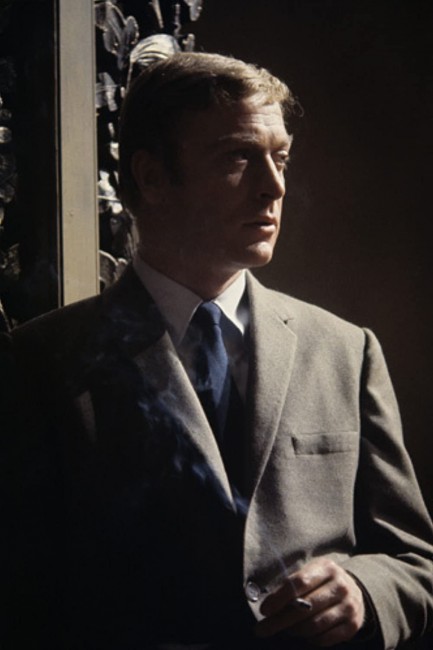
And me? I basically get to play myself, because, well, I'm Michael frickin' Caine. Plus I can't do accents.
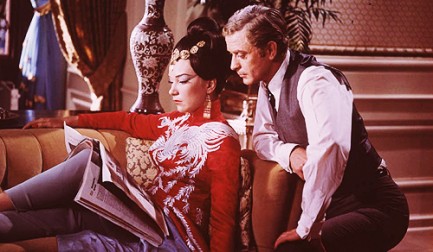
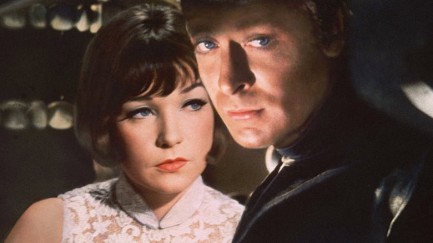
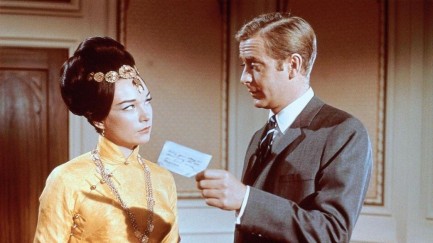
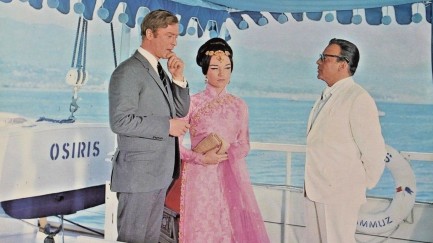
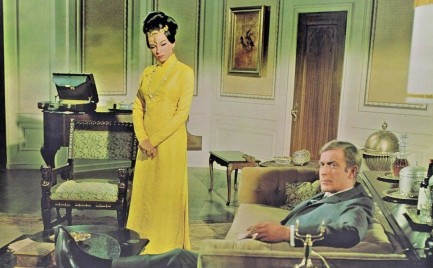
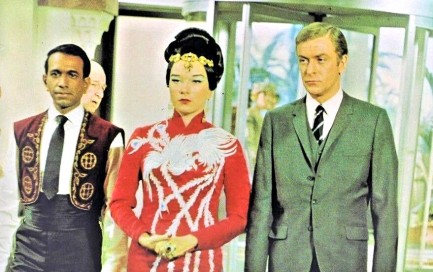
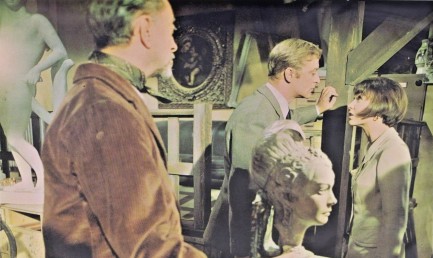
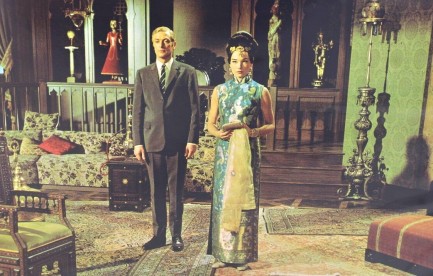
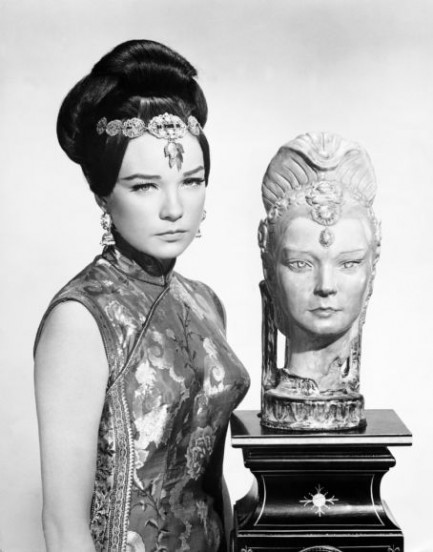 Regarding the above quips about ethnicity, they aren't completely out of the blue. We happen to be doing some work on a television series that's causing consternation online because of its casting of black and latino actors. See, there's a sizable contingent out there that wants an all-white cast in this thing, because the source material (written back when no white authors were putting characters of color in their lightweight adventure novels, because, why hurt your book sales?) is ostensibly all white.
Regarding the above quips about ethnicity, they aren't completely out of the blue. We happen to be doing some work on a television series that's causing consternation online because of its casting of black and latino actors. See, there's a sizable contingent out there that wants an all-white cast in this thing, because the source material (written back when no white authors were putting characters of color in their lightweight adventure novels, because, why hurt your book sales?) is ostensibly all white.It's a headache, dealing with these folks. Most of the complainers talk about “their” territory being encroached upon, and say idiotic things like, “Why can't blacks and latinos write their own books?” They've invented a term—“blackwashing.” These intellectually deficient people forget—or never bothered to learn—that blacks and others were erased from, let's see, pretty much every Bible movie ever made (since none of the people in the Middle East of that era were white), and pretty much every western ever made (up to 25% of cowboys in the old west were black), and those films alone comprise many thousands of opportunities, both creatively and financially, wiped out by American segregation.
A look around Pulp Intl. will reveal white actors made-up yellow to play Asians and Pacific Islanders, brown to play Native Americans, Indians, Mexicans, Arabs, and so forth. We've written about maybe two dozen such films, but there were literally thousands. Hell, even stage minstrels came about partly because audiences wanted to see comedic black performances but were for the most part not about to watch actual black men do it. So we thought Gambit would be a good moment to point out yet again the century-long erasure of actors of color from lucrative opportunities in cinema, both in front of and behind cameras, and to note that diversity in media is (inadequate) redress of a hundred years of racist exclusion.
Every time someone sees the cast in this tv show we're working on and complains about white culture being encroached upon, if you were to check their music collection you'd probably find such thefts as white guys rapping, white guys playing the blues, white guys playing jazz, and white guys playing rock and roll, from Elvis on down the line. When you include clothing, style, dance, language, and more, pretty much everything people of color have invented in America has been co-opted by white culture and magically transformed into money, while simultaneously all the literature people of color supposedly don't produce was summarily ignored by Hollywood.
Despite all we've written about this today, we're basically pretty dispassionate on the subject. White casts reflected an understanding among filmmakers of the shortest path to making money. Sure, there has long been a tiny percentage of cinema about race that had performers of color, but basically, movies were filled with whites (even if they had to wear shoe polish to play characters of color) because audiences were understood to be white. So why alienate your audience? But the diverse peoples that have always existed in America are today both more numerous and more economically significant—and the younger folks who actually fuel movie industry profits are particularly diverse. Therefore yesteryear's logic still applies for studios: Why alienate your audience?
Hollywood diversity is about making money, just as yesteryear's segregation was. We don't mind that people hate diverse casts. They're racists—duh. No further explanation needed. But what irks us is racists who pretend to be oppressed, conveniently ignoring generations of exclusion perpetrated either directly by them, or on their behalf. Nobody in their family tree was ever denied economic opportunity by nationwide industries because of skin color. People in Hollywood are in essence saying today, "Hmm.. you know, maybe it would be nice for our industry to stop screwing over people of color and actually give them some opportunities here. That's fair, right?" We think it's sad that so many people either don't get that, or pretend not to, but whatever, there's our explanation for why we joked about it above. Because behind every quip there's a story, if not an unsolicited rant.
| Vintage Pulp | Sep 18 2020 |

Carmellini issues a Terrore alert.
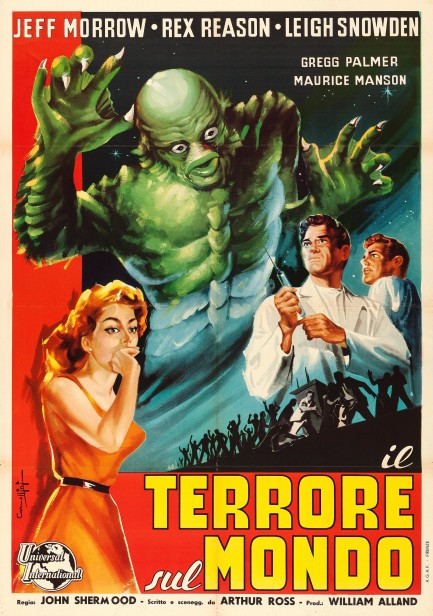
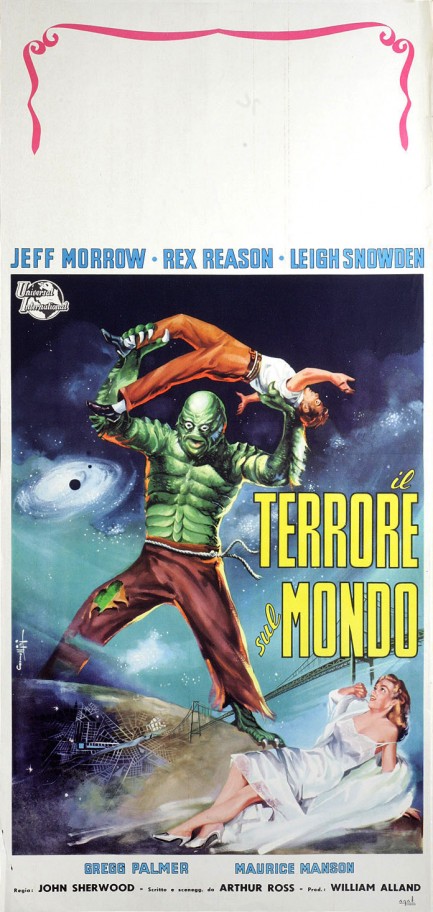
Above are two brilliant Italian posters for Il terrore sul mondo painted by an artist who signed as Carmellini. That's all we know about him, but what great work. The movie is better known as The Creature Walks Among Us. Is it as good as the posters? Are you kidding? It doesn't even deserve posters.
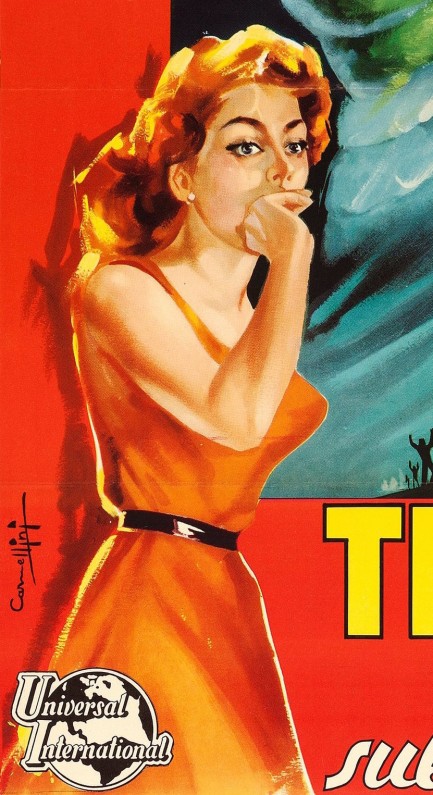
| Vintage Pulp | Oct 17 2015 |

Doris Day finds herself hunted around the clock by a demented killer.
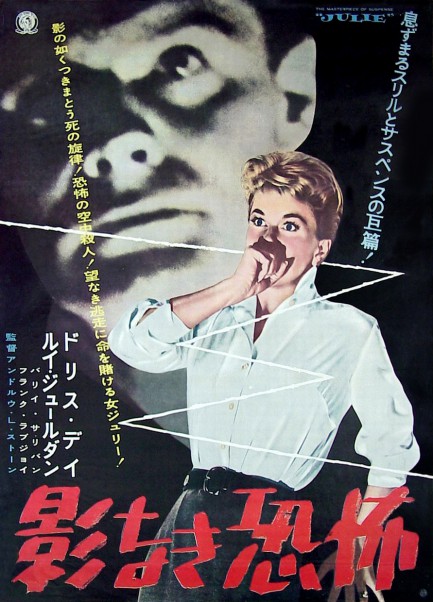
In the thriller Julie Doris Day finds out her second husband is a murderer. Who did he murder? Her first husband. No spoiler there. Day learns this within the first fifteen minutes, leaving the plot to revolve around her efforts to escape being permanently silenced for her discovery. By the end of this romp set in and around the wilds of Carmel, Monterrey, and finishing in San Francisco, she’s probably developed a fear of flying, a fear of driving, a fear of piano music, a fear of the dark, and of course a fear of ever having a third husband. It’s psychological warfare at its cruelest, and Day, along with co-stars Louis Jourdan and Barry Sullivan, do a nice job of making it all work. We don’t have a Japanese premiere date to match the nice Japanese poster above, but Julie opened in the U.S. today in 1956.
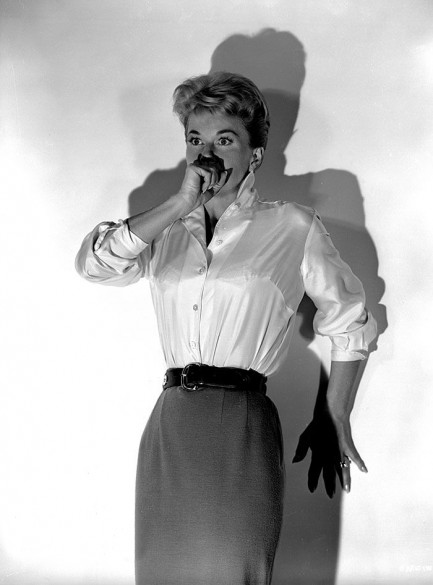
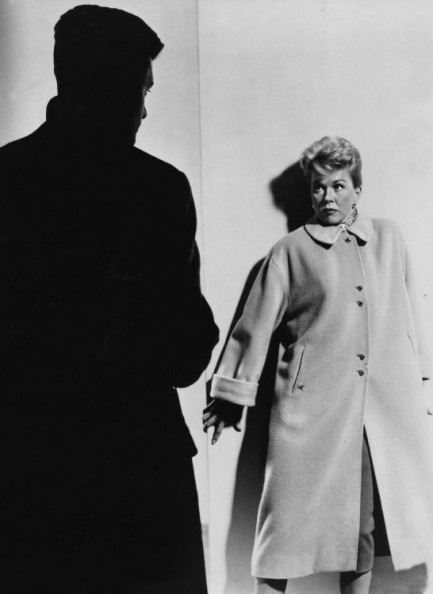
| Hollywoodland | Dec 18 2013 |

Destined to reach classic status.
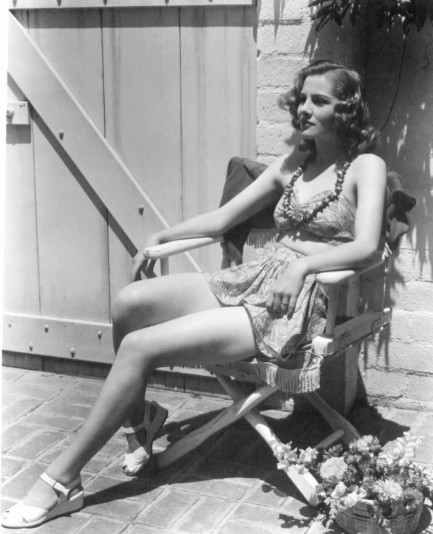
When Joan Fontaine decided to try her luck in Hollywood her mother reportedly refused to let her use the family’s name—de Havilland, which was being used by her actress sister Olivia—so she chose Fontaine as her last name. After a slow start earning good roles she scored the coveted part of Mrs. De Winter in Alfred Hitchcock’s 1940 Daphne du Maurier adaptation Rebecca and was nominated for an Academy Award. She didn’t win that one, but the next year took home the statuette for her role in Suspicion, becoming the only performer to win an Oscar for acting in a Hitchcock film.
From there her career took off, and she worked steadily through the 1940s, 1950s, and 1960s. Ironically, when her mother—a former actress—decided to rekindle her own career she did so under the stage name Lillian Fontaine. Of her famous sister, Joan Fontaine once said, “I married first, won the Oscar before Olivia did, and if I die first, she’ll undoubtedly be livid because I beat her to it.” The third part of that quip came true when Fontaine—née Joan de Beauvoir de Havilland—died of natural causes Sunday in Carmel-by-the-Sea, California.




































































